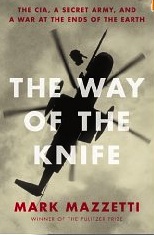Longfellow was writing in a time of war fever. The "War Between the States" (as my 1940s Georgia teacher would most certainly have called it) began on April 12, 1861.
In his poem, Longfellow was celebrating the courage of Paul Revere (above, in a modern illustration), an early American revolutionary who alerted his fellow citizens that the British were coming. Revere carried the message for the farmers and merchants that they must to be ready for the attack.
Reinhold Niebuhr is a theologian whose work helped shape President Obama's keen sense of the ambiguity of political power, before and after change. As I noted in a previous posting, Niebuhr made an important point that applies to leaders who are called to employ coercion in the course of their duties.
Niebuhr wrote in Moral Man and Immoral Society that "moral reason must learn how to make coercion its ally without running the risk of a Pyrrhic victory in which the ally exploits and negates the triumph."
When Barack Obama was elected president in 2008, he inherited a war machine President George W. Bush had assembled in response to attacks on this nation on September 11, 2001. It was a machine barreling down history's highway powered by fear, patriotism, revenge, and a genuine need to protect the American people.
It was not a machine easily slowed down nor turned around.
In his new book, The Way of the Knife, Mark Mazzetti writes that the special prison in Cuba is entirely the creation of this nation's post 9/11 war fever. Mazzetti gives credit for Guantanamo to former CIA official Jose Rodriguez, director of the Bush administration's Counterterrorism Center from 2002 to 2004.
George Tenet was CIA director in that same period. Tenet held daily 5 p.m. meetings in his office where senior CIA officials "received daily battlefield updates about operations in Afghanistan and elsewhere." Mazzetti writes:
"It was during one of those sessions that Rodriguez made an offhand suggestion that would lead to one of the most fateful decisions of the Bush Administration."
The discussion on that occasion centered on how the American military should deal with the Taliban fighters "American troops and CIA officers were picking up in Afghanistan" where they could be held "over the long term."
Various suggestions from officers were offered, including "the Ushuaia prison, on Argentina's Tierra del Fuego, a desolate facility at the bottom of the world. Another suggested the Corn Island, two tiny specks in the Caribbean Sea off the Nicaraguan coast. But all of these suggestions were dismissed as unrealistic options. Finally Rodriguez offered up an idea, almost in jest, 'well, we could put them at Guantanamo Bay', he said."
This evoked laughter around the table as US CIA officials thought "how much it would anger Fidel Castro if the United States were to jail prisoners of its new war on the American military base in Cuba."
After more discussion, the idea of Guantanamo gained support:
"It was an American facility and the fate of the prison would not be jeopardized there as it could be in another country if the government changed leadership and decided to kick the American prisoners out. And the CIA officers figured a prison at Guantanamo Bay would be outside the jurisdiction of American courts. A perfect location, it seemed.
"Cuba became the top recommendation for the new American prison, and soon enough the agency would build its own secret jail in one corner of the Guantanamo Bay prison complex. A maximum security facility, it was dubbed Strawberry Fields by CIA officials because the prisoner presumably would be there, as the Beatles sang, 'forever'".
(Note: You can view every article as one long page if you sign up as an Advocate Member, or higher).






